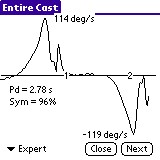|
As I'm sure most of you are aware by now, Bruce Richards and Noel Perkins have developed a electronic flycasting analyzer. Bruce has kindly given me permission to use the following...
About the Analyzer - Bruce (on the Board)
Noel Perkins has developed two different devices to accomplish much the same goal. First, he uses a rate gyro to measure rod butt angular rotation. He has also attached a strain guage to the rod to measure rod flex. Both these devices attach to the butt of the rod and have no effect on the cast, you can't feel they are on the rod.
Knowing the butt rotation and rod flex allows him to accurately calculate tip path (but only in one plane) and speed which can be easily graphed. We have compared the calculated path to video of the same cast to assure that it is accurate, and it is. It would be easy to do the same for a second plane by adding a 2nd rate gyro to the rod butt, 90 degrees from the first.
We only have one rod equipped with a strain guage, it must be glued to the blank. The rate gyro can be quickly attached to any rod and is very portable and easy to use.
On butt acceleration
The butt acceleration can be either linear or exponential, although
exponential is better. If butt accel. is linear odds are the loop will be big and rounded, or tail. Big if
the previous loop left a lot of slack in the line (as would be the case if
the previous loop was crap [technical term there from Bruce, sorry about that]).
If the rod butt accelerates with little load
the rod won't bend much and the tip will rise. If butt acceleration
continues at the same linear rate the line will eventually pull sorta
straight, the rod will start to bend. The caster will have to continue the
stroke farther than he should to put enough power in the line which means
the rod tip path will be a big upward (convex) arc.
If the caster throws
way too hard it would be possible to also make a tailing loop with the same
linear acceleration. If the line finally pulls straight when the rod is
moving really fast it will cause the tip to overbend and go concave for a
short distance at least, but the most common result is a big loop.
I've
attached an actual profile from last weekends school (a "before" profile,
his "after" looked much better). It is reversed, the curve above the center
line is his backcast, below is fore cast.
Both are relatively linear, but he threw a big sloppy backcast, and every
fore cast tailed, even though both accelerations are rather linear. The
difference is easy to see, the back cast was a slow, lazy stroke (max velocity
139 deg/sec), the back cast was a sharp, hard stroke, almost 50% faster.
Because the rebounds in both cases are low I know that the rod didn't load
much in either case which is a dead giveaway for bad loops. To compare I've
attached one of my casts, same rod, same length of line. Of most note is
the much slower acceleration, but much bigger rebounds, indicating good rod
load. Also, the very smooth exponential acceleration of the curves.
You can't tell everything you want to know by looking at only one part of
these charts, they all tie together to tell the whole story.
(these charts show the butt's angular velocity vs time)
Student

Bruce

Further analysis
The top chart shows tip speed, of a "normal" good med. dist. cast. Both fore and back cast speed is
charted above the 0 line. The chart
below shows both rod butt acceleration (solid line) and rod flex (dotted
line). I've drawn vertical lines down from max tip speed so you can see
what the rod butt is doing and what rod flex is at that point. The charts
may not be lined up exactly so there will be some minor error, but you get
the idea. I believe that the first and third tip speed peaks are back
casts, the middle is a fore cast. Lots of variables, hard to develop many
firm, fast rules.......
top: tip speed vs time
bottom: rod butt angular velocity (solid) & rod flex (dotted) vs time
|

